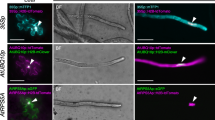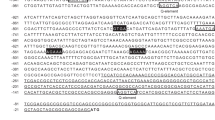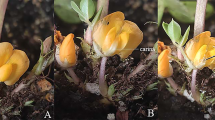Abstract
To study pollen-specific gene expression, fast and convenient methods involving in vitro pollen germination and bombardment with promoter deletion constructs are needed. Unfortunately, because of variation of pollen germability and tube growth, conducting these experiments is often unsatisfying for many plant species, including maize, especially when pollen is collected at different times of the day or season. We have overcome these problems by defining a novel medium (PGM) that guarantees germination efficiencies of more than 90% for maize pollen from at least 7 genotypes (A188, AC 3572 C, B73, H99, Hi-II, Q2, Tx232). This medium is also suitable to germinate pollen of other monocot species, such asPennisetum americanum andTradescantia species, and dicot species, such asArabidopsis thaliana, Arachis hypogaea, Columnea oesterdiana, Nicotiana tabacum, Phaseolus vulgaris, Pisum sativum, Solanum lycopersicum, Solanum tuberosum, andVicia faba. On average, reproducible germination rates ranging from 50–100% were observed with all plant species tested. In addition, we report a transient transformation assay using the luciferase (Luc) reporter gene. Biolistic parameters were defined to obtain reproducibleLuc activity measurements after bombarding thick-walled pollen, such as maize pollen. For comparison, samples of germinated maize and tobacco pollen were bombarded with the reporter gene under control of the constitutive ubiquitin-and pollen-specificZmMADS2 maize promoters. The important parameters necessary to apply both in vitro pollen germination and transient transformation for a large range of plant species are discussed.
Similar content being viewed by others
Abbreviations
- PGM:
-
pollen germination medium
- RT:
-
room temperature
- ZmMADS2 :
-
Zea mays MADS-box gene 2
References
Bate N and Twell D (1998) Functional architecture of a late pollen promoter: pollen-specific transcription is developmentally regulated by multiple stage-specific and co-dependent activator elements. Plant Mol Biol 37: 859–869.
Bedinger P (1992) The remarkable biology of pollen. Plant Cell 4: 879–887.
Bedinger P and Edgerton MD (1990) Developmental staging of maize microspores reveals a transition in developing microspore proteins. Plant Physiol 92: 474–479.
Christensen AH and Quial PH (1996) Ubiquitin promoter-based vectors for high-level expression of selectable and/or screenable marker genes in monocotyledonous plants. Transgenic Res 5: 213–218.
Custers JBM, Oldenhof MT, Schrauwen JAM, Cordewener JHG, Wullems GJ, and van Lookeren Campagne MM (1997) Analysis of microspore-specific promoters in transgenic tobacco. Plant Mol Biol 35: 689–699.
de Wet JR, Wood KV, DeLuca M, Helinski DR, and Subramani S (1987) Firefly lucirerase gene: structure and expression in mammalian cells. Mol Cell Biol 7: 725–737.
Eyal Y, Curie C, and McCormick S (1995) Pollen specificity elements reside in 30 bp of the proximal promoters of two pollen-expressed genes. Plant Cell 7: 373–384.
Gallusci P, Salamini F, and Thompson RD (1994) Differences in cell type-specific expression of the geneOpaque 2 in maize and transgenic tobacco. Mol Gen Genet 244: 391–400.
Hamilton DA, Roy M, Rueda J, Sindhu RK, Sanford J, and Mascarenhas JP (1992) Dissection of a pollen-specific promoter from maize by transient transformation assays. Plant Mol Biol 18: 211–218.
Hamilton DA, Schwarz YH, and Mascarenhas JP (1998) A monocot pollen-specific promoter contains separable pollen-specific and quantitative elements. Plant Mol Biol 38: 663–669.
Heuer S (1999) Isolierung und Charakterisierung von cDNAs aus Eizellen und Pollen von Mais (Zea mays L.) mit Homologie zu MADS-Box-Transkriptionsfaktoren. Ph.D. Dissertation. University of Hamburg, Shaker, Aachen. ISBN 3-8265-6603-3.
Heuer S, Lörz H, and Dresselhaus T (2000) The MADS box geneZmMADS2 is specifically expressed in maize pollen and during maize pollen tube growth. Sex Plant Reprod 13: 21–27.
Jefferson RA, Kavanagh TA, and Bevan MW (1987) GUS fusions: β-glucoronidase as a sensitive and versatile gene marker in higher plants. EMBO J 6: 3901–3907.
Luan S and Borgorad L (1992) A ricecab gene promoter contains separatecis-acting elements that regulate expression in dicot and monocot plants. Plant Cell 4: 971–981.
Mascarenhas JP (1966) Pollen tube growth and ribonucleic acid synthesis by vegetative and generative nuclei ofTradescantia. Amer J Bot 53: 563–569.
McCormick S (1993) Male gametophyte development. Plant Cell 5: 1265–1275.
Miyoshi H, Usami T, and Tanaka I (1995) High levels ofGus gene expression driven by pollen-specific promoters in electroporated lily pollen protoplasts. Sex Plant Reprod 8: 205–209.
Neuffer MG, Coe EH, and Wessler SR (1997) Mutants of maize, p 311. Cold Spring Harbor Laboratory Press.
Ow DW, Wood KV, DeLuca M, DeWet JR, Helinski DR, and Howell SH (1986) Transient and stable expression of the firefly luciferase gene in plant cells and transgenic plants. Science 234: 856–859.
Seliger HH and McElroy WD (1960) Spectral emission and quantum yield of firefly bioluminescence. Arch Biochem Biophys 88: 136.
Takaiwa F, Oono K, and Kato A (1991) Analysis of the 5′ flanking region responsible for the endosperm-specific expression of a rice glutelin chimeric gene in transgenic tobacco. Plant Mol Biol 16: 49–58.
Torres MA, Puigdomènech J, and Stiefel V (1995) Specific distribution of mRNAs in maize growing pollen tubes observed by whole mountin situ hybridization with non-radioactive probes. Plant J 8: 317–321.
Twell D, Klein TM, Fromm ME, and McCormick S (1989) Transient expression of chimeric genes delivered into pollen by microprojectile bombardment. Plant Physiol 91: 1270–1274.
Walden DB (1994) In vitro pollen germination. In: Freeling M and Walbot V (eds), The Maize Handbook, pp 723–724, Springer, New York, Inc.
Xu H, Davies SP, Kwan BYH, O'Brien AP, Singh M, and Knox RB (1992) Haploid and diploid expression of aBrassica campestris anther-specific gene promoter inArabidopsis and tobacco. Mol Gen Genet 239: 58–65.
Author information
Authors and Affiliations
Additional information
An erratum to this article is available at http://dx.doi.org/10.1007/BF02772809.
Rights and permissions
About this article
Cite this article
Schreiber, D.N., Dresselhaus, T. In vitro pollen germination and transient transformation ofZea mays and other plant species. Plant Mol Biol Rep 21, 31–41 (2003). https://doi.org/10.1007/BF02773394
Published:
Issue Date:
DOI: https://doi.org/10.1007/BF02773394




